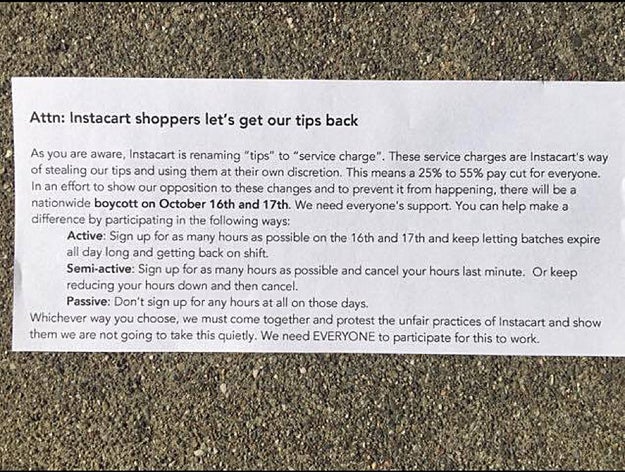Instacart CEO: Some Workers Must Earn Less For The Company To Grow
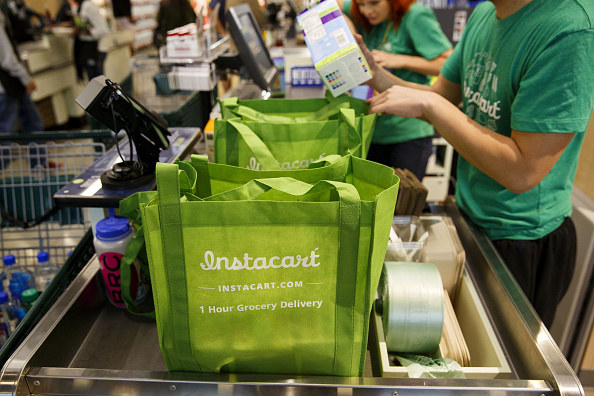
Bloomberg / Getty Images
Instacart workers are earning a lot less money after changes to the company’s pay structure — changes CEO Apoorva Mehta told BuzzFeed News are necessary for the company’s continued growth, but that hundreds of vocal Instacart shoppers say are threatening their livelihoods. According to a Buzzfeed News analysis of 15 workers’ pay stubs, shifts that once earned shoppers $100 or more in 4 to 8 hours have dropped closer to $60 to $80 for similar shifts. These shoppers estimate their earnings have fallen by around 30% so far.
When Instacart announced in September that it would be updating the way shoppers get paid, replacing its tips-based pay system with a pooled “service amount,” a company blog post described in detail how the changes would both increase driver pay and stabilize their earnings. But now, one week after the update rolled out in most markets, many shoppers who spoke with BuzzFeed News said the change has made working for Instacart non-viable.
Remington Donovan, an L.A. filmmaker, told BuzzFeed News he relied on tips to make an average hourly earning of around $25 an hour, which is twice L.A.’s minimum wage. But Instacart replaced those tips, which went directly to the individual worker delivering your groceries, with a fee that is collected by the company and distributed among all shoppers. Customers can still tip on the platform after an order is delivered, but that’s in addition to the service amount, and shoppers say the new tipping feature is hard for customers to find.
“Out of seven orders on one day, I only got two tips,” said Donovan. “My income decreased enough in just a couple days that by my assessment, it just won’t be worth it for me.”
The shoppers’ main complaint is that, although it is still possible to leave tips via Instacart’s platform, the tip feature is now hard to find, and customers, who were never explicitly told about the change, don’t realize they’re no longer leaving tips. Donovan called the move “knavish subterfuge.” Mehta says, from his perspective, “tipping is extremely, clearly, visible” in the app.
But some customers disagree. “I'm a longtime user of Instacart and I love the service, but I&039;m very frustrated. I wanted to leave a tip, but I couldn&039;t figure out how, and I work in tech!,” said Nicole Sullivan, a San Francisco based project manager. Some shoppers are taking time to explain how the new tip system works when they make deliveries, but even that might not solve their problem.“I finally found a way to add it,” Sullivan said, “but I can&039;t add a 15% tip on top of a 10% service fee on top of groceries that are more expensive than they would be in the store. It’s too expensive&033;”
While some low-earning shoppers will benefit from the pooled service amount, Mehta told BuzzFeed News that, for shoppers who were earning significantly above market rate wage, “the wages are reduced.” Indeed, paystubs shared with BuzzFeed News by more than a dozen shoppers do suggest tipping has decreased significantly since the changes rolled out.

A flyer distributed to customers by Instacart shoppers explaining how to leave a tip.
(The vast majority of shoppers who spoke with BuzzFeed News for this article asked to remain anonymous out of concern that their accounts would be deactivated for speaking with the press; Instacart said it has never deactivated workers for speaking publicly about their experience with the company.)
For example, a female driver in Denver earned around $90 on Instacart during a four and a half hour shift on a Monday in October prior to these changes; over $50 of that 100 came from tips. The following Monday, the first day the changes took place, she earned only $60 in six and a half hours, and received only 19 dollars in tips. She said if the trend continues, she’ll have to find another job.
Like many other shoppers, she believes that Instacart is intentionally allowing customers to believe that the automatic 10% “service amount” is a tip that goes directly into her pocket. “I will not continue working for Instacart at this low of pay, and while customers are being tricked into thinking they left a tip,” she said in an email. Other shoppers had similar experiences. Six of the shoppers who shared their pay stubs got no tips at all, and three more made less than $5 in tips following the change. In the week before, most of them earned around $50 in tips, with three of them earning more than $100 in tips.
Only a portion of all Instacart shoppers — those who do both shopping and delivery and are independent contractors, not the ones who work in-store and are employees — were impacted by the pay structure changes, but the group has nonetheless been notably vocal on social media and successful in building momentum around their cause. There are two active Facebook groups, each with a couple hundred members, plus an Instagram page, a popular hashtag #wheresthetipinstacart, and an anonymous open letter on Medium. The shoppers use these methods to share information about what they’re earning, as well as distribute materials like a flyer to explain what’s going on to customers. There’s even a website, Instawtf.com, where almost 1,000 people have pressed a big red button to tweet “wtf” at Instacart’s Twitter account.
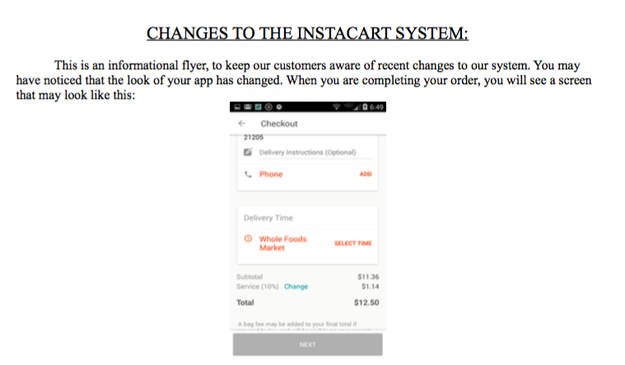
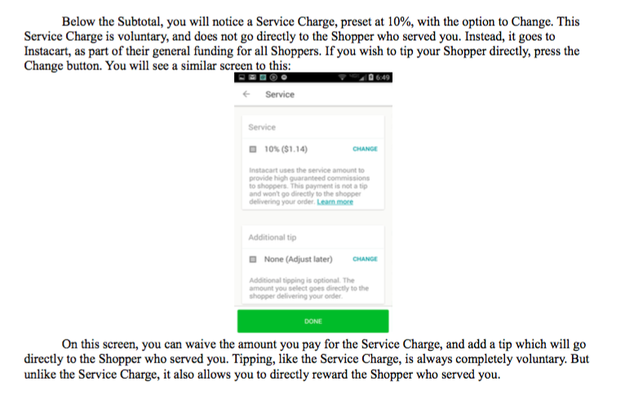
These shoppers are hopeful that their combined efforts will convince Instacart to revert to a tips based system. But Mehta says that’s unlikely to happen. The purpose of changing the system, he told BuzzFeed News, was to “bring consistency to our model as we go from tens of thousands of shoppers to doubling that by the end of next year.”
The goal, Mehta said, is to have shoppers earning an average “market clearing wage” — so, in San Francisco, between $16 and $22.50 an hour. “If you are making more than that as a shopper, then your wage will go down,” said Mehta. “If you were making less, your wages will go up.” Instacart is confident that plenty of shoppers will be willing to work for the new rate, which Mehta said changes daily based on supply of workers and demand for orders in a particular market. In fact, since the new dynamic pay model started on Instacart, that base rate has already started to fall. In two Bay Area zones, for example, the new base pay rate rolled out at around $10 per trip, but was already below $9 per trip within a week, according to screenshots shared with BuzzFeed News.
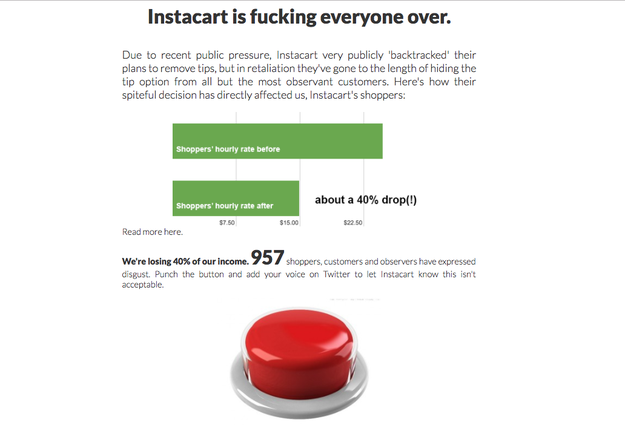
As independent contractors, Instacart isn’t required to pay its full-service shoppers a particular amount — not even minimum wage. Like any free labor marketplace, Instacart only has to pay whatever it takes to keep its supply of workers steady. Even if some of the shoppers who are now earning less money quit, it doesn’t seem like that will be a problem for Instacart, at least not right away.
“We want to continue to hire, and double the fleet that we have,” said Mehta. “The way we’re going to be able to do that is to make sure it’s a great place for shoppers to earn a fair and competitive wage.”
But while it’s undoubtedly true that there are people willing to work for what one Instacart shopper on Facebook called “McDonald’s wages,” those who have been in the on-demand game a little while are concerned this move is just the beginning of a continuous crunch for Instacart shoppers, and other independent contractors who aren’t protected by employment law.
“Instacart is a great idea and a great company. It can be frustrating, but overall it&039;s been a fun job for me, part time,” Donovan said. “But I don’t think this is the right way to do business. We need to send a message to other on-demand businesses: this isn’t right.”
Quelle: <a href="Instacart CEO: Some Workers Must Earn Less For The Company To Grow“>BuzzFeed

